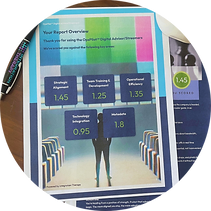The Gap Between Technology and Implementation in Media Operations
- Rebecca Avery
- Jan 2
- 3 min read
Updated: Mar 18

Article Summary
New technology is only valuable when it actually solves the right problems. In the media industry, it's easy to chase the latest platform or tool, but true transformation happens when technology is aligned with how teams actually work. This article explores why operational integration matters more than shiny features, and how thoughtful implementation is what turns tools into impact.
The Real Value of Technology Starts with Operational Alignment
There’s no shortage of excitement around new technology in media. Whether it’s artificial intelligence, next-generation content management systems, or advanced analytics platforms, the promise is always the same: faster workflows, smarter decisions, and a sharper competitive edge.
But here’s the reality: technology doesn’t solve problems on its own. Tools only drive progress when they are fully aligned with the operational needs of the people using them.
Without that alignment, even the most advanced systems can become just another layer of complexity.
Technology Without Strategy is Just Noise
One of the most common missteps media companies make is adopting new tools before addressing the processes those tools are meant to improve. When systems are rolled out without a clear understanding of existing workflows, the result is frustration instead of progress.
Consider what happens when a content management system doesn’t match the pace or structure of your production pipeline. Or when a project management platform feels clunky to a creative team trying to stay in flow. These tools become blockers instead of enablers, and teams start working around them instead of with them.
It’s not the technology that fails. It’s the implementation.
Operational Integration Is the Missing Link
The real power of technology lies in how well it fits into your day-to-day operations. That means asking thoughtful questions before you invest in tools:
What is the workflow this tool is supposed to support?
Where are the current bottlenecks or pain points?
Who will use it, and how will it change the way they work?
This kind of thinking shifts the focus from features to fit. From product specs to real-world outcomes.
When technology is implemented with operational alignment in mind, it becomes something much more powerful. It becomes a lever for growth, not just another system to manage.
What Happens Without Integration
When operational strategy takes a back seat to technology hype, the consequences are predictable:
Inefficiency increases instead of decreasing.
Teams resist change, because the tools don’t feel helpful.
Resources are wasted on software that never delivers full value.
These are avoidable outcomes. But they require planning, context, and a focus on how people actually get work done.
Building a Bridge Between Tools and Teams
Operations is the connective tissue between what technology can do and what teams actually need. That’s why your operational leaders should be front and center in any technology adoption effort. They bring the insight required to design integrations that feel seamless and effective.
Successful integration involves more than installing software. It requires:
A clear understanding of key workflows
Practical user training that supports adoption
Ongoing evaluation to make sure the system evolves with your business needs
This is not a one-time effort. It’s a continuous process that blends strategic intent with real-time feedback from the teams using the tools.
Technology is Only as Strong as Its Integration
The takeaway is simple. Technology should never be the strategy. It should support the strategy. When it’s well aligned, it unlocks efficiency, empowers teams, and builds a strong foundation for growth.
But without thoughtful integration, even the best tools can become barriers.
The companies that get this right are the ones that prioritize how work actually gets done. They don’t chase the newest trend. They build systems that work for people first, and scale from there.




.png)